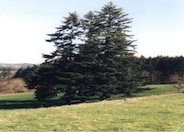
Common name:Douglas Fir
Botanical name:Pseudotsuga menziesii
On older trees of this variety, the bark is thick, corky, and deeply fissured. The crown changes from a conical form and becomes broad and flat-crowned with age, making the branches wide and drooping. Its cones are 3"-4" long, and have 3 pointed bracts that extend beyond the needles of the scales. The buds are cigar-shaped, and the bark of the young trees is smooth and gray. This is a highly combustible plant.

Common name:Purple Coneflower
Botanical name:Echinacea purpurea
The Purple Coneflower is a long-lived, reliable standby for the perennial garden. Rosy purple petals fall below the prominent orange-tinged cone and blooms in late June to September. It should be placed toward the front or middle of the border, or interplanted with Ox-Eye Daisy in the cut flower garden. It should be grown in fertile, well-drained soil. The plant blooms well in shade, but does even better in sun. -Holland WIldflower Farm
Dealing With Drought
More than half of the water used at your home is for outside purposes. Studies show that on average, half of the water used outdoors is wasted. The leading cause of waste is incorrectly set and poorly managed irrigation controllers. The second biggest cause of wastage is broken irrigation equipment that goes undetected. There are a few basic things you can do to make a big difference in your water use.
Click in the green box for more information
| Designer: | Formal Decorative Fence |
Photographer: Duane Morris |
Soils and Compost:
Incorporate compost 6" into your soil to retain water, reduce compaction, feed earthworms, and provide valuable nutrients to your plants.
Water Saving Tip:
Mulching and adding compost to soil can minimize evaporation and help soil absorb and store water.
Integrated Pest Management:
Develop healthy soil for plants that are vigorous and naturally pest-resistant.

